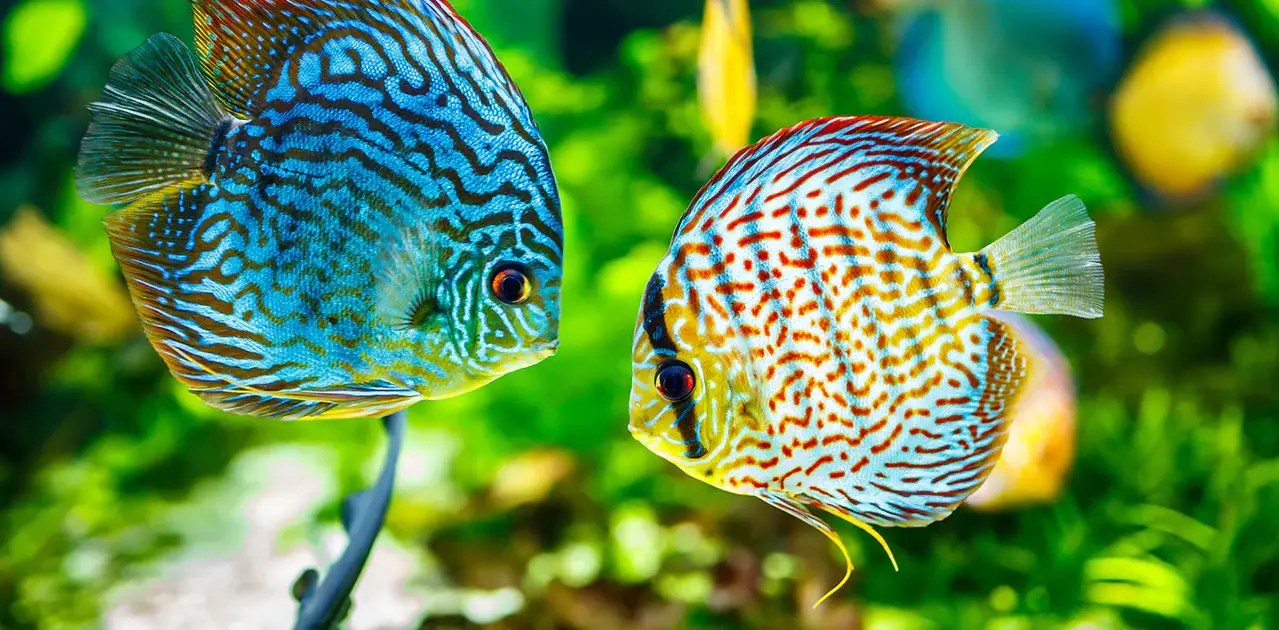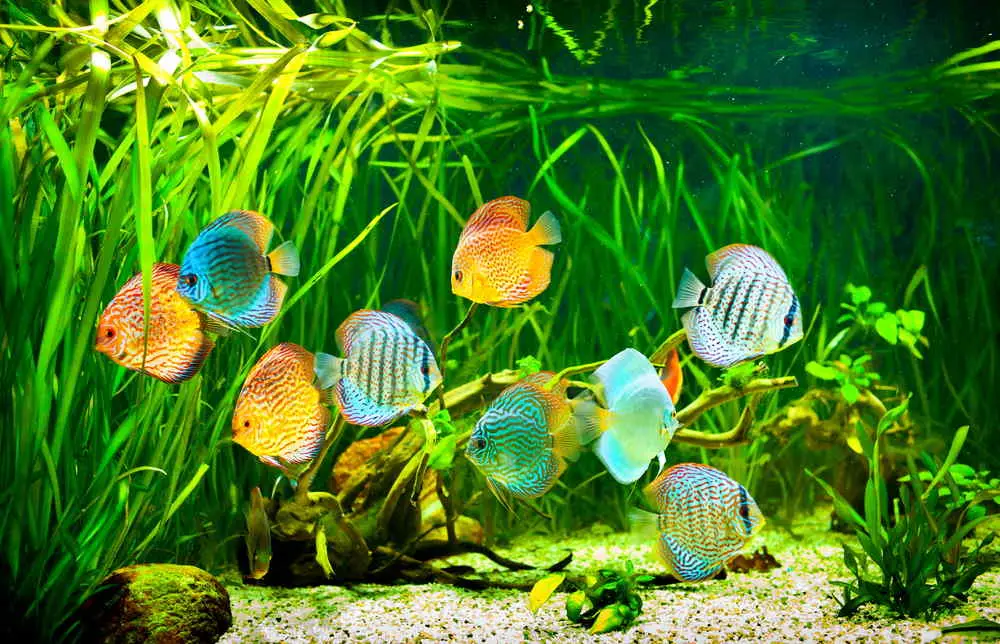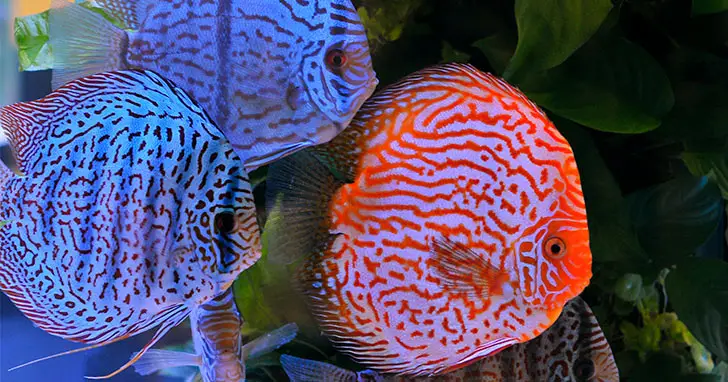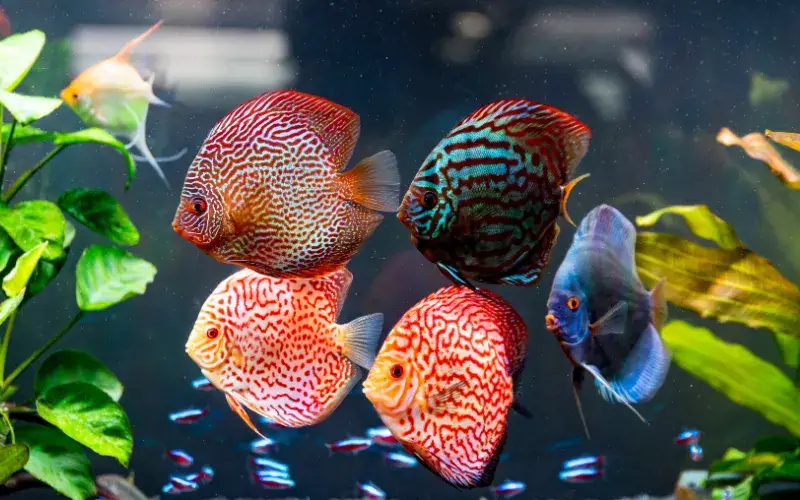If you’re a fish enthusiast looking to add a splash of vibrant colors to your aquarium, discus fish are an excellent choice. These beautiful creatures are known for their striking patterns and captivating hues.
In this article, we will explore the world of discus fish care and discover how to provide them with the proper environment, nutrition, and attention they need to thrive.
Understanding Discus Fish

Before diving into the care aspects, let’s take a moment to understand the origins and unique characteristics of discus fish. As native to the Amazon River basin, they hail from the calm, acidic waters of South America. Being natural dwellers of slow-moving rivers and flooded forests, discus fish flourish in tanks that replicate their natural habitat.
Discus fish, scientifically known as Symphysodon, are a genus of cichlids that belong to the family Cichlidae. They are highly sought after by aquarium enthusiasts for their vibrant colors and unique body shape. Let’s delve deeper into the fascinating world of discus fish.
The Origin and Natural Habitat of Discus Fish
The discus fish, hailed for its vibrant hues and distinctive rounded shape, originates from the dynamic river systems of South America. This species, scientifically known as Symphysodon, thrives in the warm, soft waters of the Amazon River basin, where it navigates intricate underwater landscapes.
In its natural habitat, the discus encounters a diverse array of fish species and often shares its living space with other tropical fish. The Amazon’s intricate ecosystem creates an environment where discus fish feel most at home, surrounded by lush aquatic vegetation.
In the wild, the discus exhibits a keen affinity for slow-moving waters, favoring locations with minimal current. This preference for tranquil settings is reflected in their behavior within the aquarium environment, making them well-suited for planted tanks where they can gracefully glide through aquatic greenery.
The water parameters of their natural habitat are notably distinct, featuring slightly acidic water conditions. To replicate this in captivity, enthusiasts often employ methods like reverse osmosis to achieve the optimal soft water that discus favor.
In the Amazon, discus fish are not solitary beings. They engage in the company of their own kind and other compatible species. This inherent social nature should be considered when keeping discus in an aquarium, ensuring a community setup with suitable tank mates like cardinal tetras and neon tetras.
Interestingly, the discus’s propensity for breeding in bare-bottomed tanks in captivity echoes their natural inclination for selecting suitable breeding sites in the wild. Creating an environment that mirrors their origin can significantly impact their comfort and encourage breeding discus pairs to exhibit their natural behavior.
As one delves into the realm of discus fish, understanding their roots in the South American waterways becomes paramount. Recreating elements of their water conditions, habitat, and social dynamics is not just a part of discus fish care; it’s a tribute to the vibrant life that originates from the heart of the Amazon.
Recognizing Different Types of Discus Fish
With a wide range of color variations and patterns, discus fish come in various breeds. The most popular types include the Bright Blue, Royal Green, Pigeon Blood, and Red Melon varieties. Each variant showcases unique patterns, making them an aesthetically pleasing addition to any tank.
The Bright Blue discus fish, as the name suggests, displays a stunning blue hue that is sure to captivate any observer. The Royal Green variety, on the other hand, exhibits a mesmerizing green coloration, reminiscent of the lush Amazon rainforest.
The Pigeon Blood discus fish features a striking combination of red and white patterns, resembling the delicate feathers of a pigeon. Lastly, the Red Melon discus fish boasts a vibrant red body with a contrasting white face, resembling a juicy watermelon.
Discus fish enthusiasts often engage in selective breeding to enhance specific traits, resulting in even more diverse and captivating color variations. This continuous breeding process has led to the creation of unique strains, such as the Leopard Skin, Checkerboard, and Snakeskin discus fish.
The Unique Characteristics of Discus Fish

The discus fish is a fascinating creature, renowned among aquarium enthusiasts for its unique characteristics and vibrant presence. Understanding the intricacies of discus fish care is essential for those seeking to keep these captivating fish in their aquarium.
One of the defining features of discus fish is their distinctive rounded shape. This characteristic sets them apart from many other freshwater fish, contributing to their graceful and elegant appearance in an aquarium setting.
When it comes to tank mates, discus fish have a preference for peace and tranquility. Aggressive fish should be avoided in the same tank, making companions like cardinal tetras or neon tetras more suitable for a harmonious community tank.
Creating an ideal discus aquarium involves paying attention to specific water parameters. Discus fish thrive in soft water with a slightly acidic pH. Keeping the water within a specific temperature range, ideally on the warmer side, enhances their well-being.
Maintaining the right water temperature is crucial. Discus fish feel most comfortable in warm water, replicating their natural habitat in South America. A reliable air pump aids in oxygenation, ensuring the well-being of these tropical fish.
For those interested in breeding discus, factors such as tank setup and aquarium plants become crucial. Some prefer bare-bottomed tanks for breeding, while live plants provide hiding spots for juveniles. A well-established planted tank contributes not only to aesthetics but also to the overall health of the fish.
The diet of discus fish is another aspect that demands attention. Offering a varied diet that includes live or frozen foods like brine shrimp ensures proper nutrition. This mimics the diet of wild discus in their natural habitat.
Understanding the tank size requirement is vital for keeping discus. While a minimum tank size of 50 gallons is recommended for an adult discus, larger tanks offer more stability and space, promoting a thriving community.
When it comes to aquarium water, discus fish prefer water that is not only warm but also free from impurities. Regular water changes contribute to maintaining optimal water quality, preventing issues such as gill flukes and waste buildup.
In a community tank, the dynamics of keeping discus alongside other fish species involve careful consideration of the number of fish and their compatibility. A well-thought-out community tank can be a delight, with discus coexisting harmoniously with other small and peaceful fish.
The unique characteristics of discus fish, from their rounded shape to their preference for warm and soft water, make them a delightful addition to any aquarium. With proper discus care, including attention to tank mates, water conditions, and diet, these fish can thrive, bringing joy to enthusiasts seeking the vibrant beauty of the discus into their homes.
Setting Up the Perfect Discus Fish Tank

Creating a suitable environment for your discus fish is vital to their overall well-being. Here are some key considerations when setting up their tank:
Choosing the Right Tank Size for Discus Fish
Discus fish prefer spacious tanks, allowing them ample room to swim and explore. A tank size of at least 50 gallons (189 liters) is recommended for a small number of discus fish. However, if you plan to keep a larger group, it’s best to opt for a tank capacity of 75 gallons (283 liters) or more.
Providing a larger tank not only gives your discus fish more space to move around but also helps maintain better water quality. With a larger volume of water, it becomes easier to maintain stable temperature and water parameters, reducing the risk of stress and disease.
When selecting a tank, consider the dimensions as well. Discus fish are known for their tall and round body shape, so a tank with a greater height rather than width is preferable. This allows them to swim vertically, mimicking their natural behavior in the wild.
Ideal Water Conditions for Discus Fish
Maintaining the proper water parameters is essential to ensure your discus fish thrive. Aim for a temperature range of 80 to 87 degrees Fahrenheit (26-30 degrees Celsius) to mimic their natural habitat. Discus fish originate from the Amazon River basin, where the water is warm and tropical.
In addition to temperature, monitoring the pH levels is equally important. Discus fish prefer slightly acidic water, with a pH range of 6 to 7 being optimal. This acidity level helps support their immune system and overall health.
When setting up the tank, it’s crucial to use a reliable water testing kit to regularly monitor the temperature and pH levels. This allows you to make any necessary adjustments to maintain a stable and healthy environment for your discus fish.
Furthermore, consider the water hardness. Discus fish thrive in soft water conditions, so using a water conditioner or adding natural additives like almond leaves can help achieve the ideal water hardness for them.
Essential Tank Equipment for Discus Fish
Aside from the basic tank essentials, such as a heater and filter, it’s crucial to consider additional equipment for your discus fish. Using a sponge filter can help reduce water flow, mimicking their natural habitat conditions. Discus fish are not strong swimmers and prefer calmer waters.
When choosing a filter, opt for one with adjustable flow settings or add a pre-filter sponge to reduce the water current. This will prevent your discus fish from getting stressed or exhausted while swimming against a strong current.
Additionally, installing a dimmable light source can provide a soothing ambiance for your fish, preventing any unnecessary stress. Discus fish appreciate a natural day-night cycle, so having a light that can mimic sunrise and sunset can help create a more natural environment for them.
Consider adding live plants to the tank as well. Not only do they enhance the aesthetic appeal of the aquarium, but they also provide hiding spots and natural filtration. Discus fish feel more secure and comfortable when they have places to hide and explore.
Lastly, don’t forget to include a high-quality water conditioner and beneficial bacteria supplement in your discus fish tank setup. These products help remove harmful chemicals from tap water and establish a healthy biological balance in the tank.
By carefully selecting the right tank size, maintaining ideal water conditions, and providing essential equipment, you can create a perfect and thriving habitat for your discus fish.
Nutrition and Feeding for Discus Fish

Like any living creature, maintaining a balanced diet is crucial for the well-being of discus fish. Here are some key factors to consider when it comes to their nutrition:
Understanding the Diet of Discus Fish
Discus fish are omnivorous, meaning they consume both meaty and plant-based foods. Providing a varied diet is essential to meet their nutritional needs. Offer them high-quality pellets or flakes as their primary food source, enriched with essential vitamins and minerals. Supplement their diet with frozen or live foods like brine shrimp, bloodworms, and daphnia to keep their diet diverse and interesting.
When it comes to the plant-based portion of their diet, discus fish benefit from the inclusion of vegetables such as spinach and peas. These vegetables provide important fiber and nutrients that contribute to the overall health of the fish.
Additionally, incorporating algae wafers into their diet can help mimic their natural feeding behavior in the wild, as discus fish often graze on algae-covered surfaces.
Feeding Schedule and Portions for Discus Fish
Establishing a consistent feeding schedule helps maintain the health of your discus fish. Feed them two to three times a day, offering an amount they can consume within five minutes. Overfeeding can lead to digestive issues, so it’s important to monitor their feeding habits and adjust portions accordingly.
It’s worth noting that discus fish have a slower metabolism compared to some other tropical fish species. Therefore, it’s important to avoid overfeeding, as excess food can lead to water quality issues.
By providing smaller, more frequent meals, you can ensure that the fish are getting the nutrients they need without compromising their overall health.
Best Food Options for Discus Fish
While there are numerous food options available for discus fish, it’s essential to select high-quality products that support their nutritional requirements. Look for reputable brands that offer specially formulated discus fish food, both in dry and frozen forms.
Consulting with experienced fishkeepers or your local pet store can provide valuable insights into the best food options available.
In addition to commercial fish food, discus fish can also benefit from the occasional supplementation of live or frozen foods. These foods not only provide additional nutrients but also stimulate the natural hunting instincts of the fish.
Live foods such as blackworms, mosquito larvae, and even small crustaceans can be offered as a treat to enhance their diet and provide enrichment.
It’s important to note that when introducing new foods to discus fish, it’s recommended to do so gradually. Sudden changes in diet can lead to digestive issues or stress. By slowly incorporating new foods into their diet, you can ensure that the fish have a smooth transition and adapt well to the changes.
Health and Disease in Discus Fish

Ensuring the well-being of your discus fish entails properly addressing their health and potential diseases. Let’s dive into some preventive measures and treatments:
Common Health Issues in Discus Fish
Discus fish are generally hardy, but they can still be susceptible to various health issues. Common ailments include bacterial infections, parasitic infestations, and stress-related diseases. Bacterial infections can manifest as fin rot, ulcers, or cloudy eyes.
Parasitic infestations, such as ich or flukes, can cause irritation, scratching, and loss of appetite. Stress-related diseases, like hole-in-the-head disease or lateral line erosion, can occur due to poor water conditions or improper diet.
It is important to keep a close eye on the behavior of your discus fish. Any changes in their swimming patterns, appetite, or appearance should be noted and attended to promptly. Early detection and intervention can help prevent these health issues from escalating and causing further harm to your beloved fish.
Preventing Disease in Discus Fish
Maintaining a clean and well-maintained tank greatly reduces the risk of disease in discus fish. Regular water changes, typically around 25% every week, help remove accumulated waste and maintain optimal water parameters.
Proper filtration is crucial to remove toxins and maintain water quality. A combination of mechanical, biological, and chemical filtration methods can be employed to ensure a healthy environment for your fish.
In addition to regular maintenance, quarantining any new fish before introducing them to the main tank is highly recommended. This practice helps prevent potential diseases from spreading to the existing fish population.
Quarantine tanks should be set up with similar water conditions and closely monitored for any signs of illness. New fish should undergo a quarantine period of at least two to four weeks to ensure they are healthy and free from any contagious diseases.
Treating Sick Discus Fish
If you notice any signs of illness in your discus fish, swift action is necessary to ensure their recovery. Consult with a veterinarian experienced in fish care or seek guidance from knowledgeable fishkeepers. They can provide valuable insights and recommend appropriate treatment options.
Treating diseases in discus fish often involves administering medication to alleviate symptoms and restore their health. Antibiotics are commonly used to treat bacterial infections, while anti-parasitic medications are effective against parasitic infestations.
It is important to follow the prescribed dosage and treatment duration to ensure the best possible outcome for your fish. Alongside medication, maintaining optimal water conditions, providing a balanced diet, and minimizing stressors can aid in the recovery process.
Remember, prevention is always better than cure. By implementing proper preventive measures, such as maintaining a clean tank, quarantining new fish, and providing a stress-free environment, you can significantly reduce the risk of disease in your discus fish.
Regular observation and prompt action are key to ensuring the long-term health and well-being of your aquatic companions.
In Conclusion
Taking care of discus fish is a rewarding experience that allows you to appreciate the beauty and grace of these vibrant creatures. By understanding their needs for the ideal tank setup, proper nutrition, and health management, you can ensure a thriving and colorful aquatic environment.
Remember to regularly observe and interact with your discus fish, as their engaging behavior will surely bring joy and tranquility to your aquarium.

